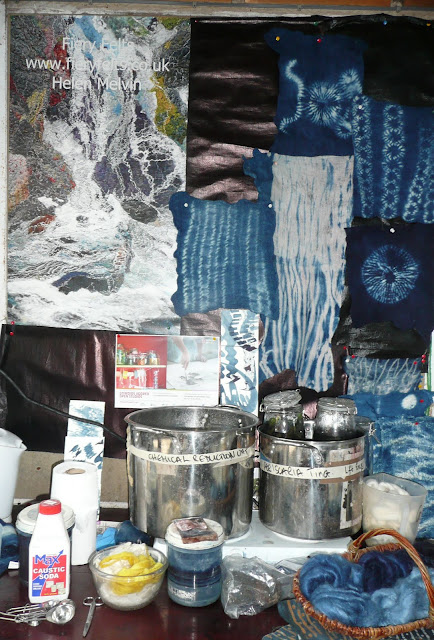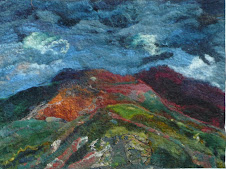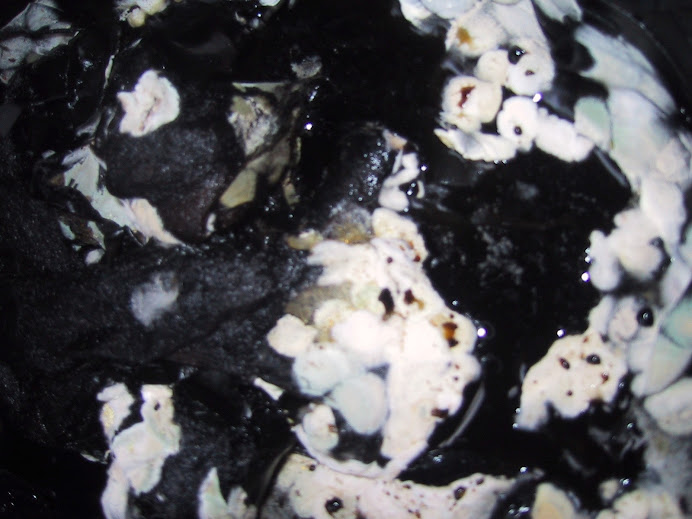I started this on Tuesday night. as I want it for my Dyeing the Blues Workshop on Saturday.
Recipe
The recipe calls for 9 litres of water but I filled up a small stainless steel pot- I think it might be 6litres
60g madder
30g bran
500ml of wood ash lye at pH 14. ( This is the last of my oak ash lye). I put this as even though in proportion it might be too much but somehow I thought it would be okay. and as it turned out the final pH of the solution was 9 verging on 10 which was fine and in fact the one important and critical measurement (along with the temperature)
25g of finely ground indigo.stirred with hot water to a paste. The recipe called for 22g but I had a packet of 25 g so what the hell! It all went in. Would 3g really make a difference?
I boiled the madder and bran , wood ash lye ,and water for twenty minutes, allowed it to cool to 40 degrees C before adding the indigo paste, covered and placed on the heating pad to keep warm. pH was 9. Incidentally a scientifically minded friend though the boiling was to get rid of the alizarin in madder. Certainly the froth goes a fabulous purple or dark red colour.(I have had both colours). On this occasion it was more a dark red.
Wednesday am. The vat was 38 degrees, a few bubbles on the surface. pH 9. Stirred . The vat is starting to smell that characteristic slightly sweet smell
Wednesday pm The vat was 42 degrees pH had dropped to 6. I added 2 tablespoons of sodium carbonate ( washing soda). The pH drops because of the lactic acid produced by fermentation and at this stage you need to check the vat twice a day as pH can drop rapidly as you can see. If the vat becomes acid the vat is described as going sour and the indigotin is lost.Vat smelling
Thursday am The vat was pH 7 I stirred added 2 tablespoons of washing soda, stirred and checked again. pH was now 9.
Thursday pm about 5. The vat had dropped to about pH8 and was nicely warm at 42 degrees C.
I checked it again at 7 ish and it had dropped to Ph 6-7 so I stirred , and added 2 tablespoons of washing soda. I used to make a solution and indeed used to use wood ash lye but this either means adding cold liquid which cooled the vat down or heating it up and now I find adding washing soda works fine. If in doubt as to howmuch to add add a little like a teaspoon , stir and check the pH.
Friday am
Ph7-8 37 degrees C!-it seems to have been really cold overnight as the studio felt really cold this morning to the extent tha\t I discussed with DH lighting the wood burner to take off the chill.
I stirred, added 1 tablespoon of washing soda to pH 9.
The vat had an indigo sheen this morning as well as a slight froth and the sweet fermented smell . I added some newly washed teeswater ( about 25g) down the side of the vat. At first I thought they went an olive green then perhaps a more yellowy colour. Anyway I have left them in till this evening or possibly till tomorrow when the workshop starts.
Friday pm
pH 7-8
Stirred added 1 tablespoon of washing soda. Forgot to takethe temperature.
I have changed the title of my blog- this morning it seemed funny tonight feeling down it seemed offensive. .
I have lost a follower I wonder why?
Madder bran vat day 3.5 sheen of indigo flower on surface
very gradually the fibres turned a darker green but not really a blue.
Saturday
Vat was 35 degrees C PH was 8, so Iadded a tablspoonof washing soda to bring it up to 9 and the little vat dyed all the day coping with 6 students putting two lots of stuff in each. A lot of the fibres still had this strange green cast and my other thought was that there was some yellow dye in the pan left after dyeing otherwise I really cannot account for it. In the evening I just stirred it and left it.
A tidy studio ready for 6 students!
The Blue Table
The results on the airer. The students had 100 g of merino, half a silk cap, some silk chiffon, and could pick from teeswater, silk cocoons, carrier rods.and some yellow merino dyed with Gensita Tinctoria as as well as dyed teeswater. I think everyone had to work quite hard but they all dyed everything in their packs and some managed repeated dips for a darker blue
On the Dyeing the Blues Day. We dyed with fresh woad leaves, fresh Persicaria Tinctoria for blue and in acidulated water for turquoise-hanging at the further end of the airer. We made up a Chemical reduction vat and the students were able to use a fermented vat. The woad was better than I thought but the persicara-grown in Enys's greenhouse - was superb. We did not have time to use the persicaria vat made form my home grown leaves so I am going to use that this morning.
Sunday
Much to my surprise this morning the fermented vat had bubbles on the surface and the pH was 9 Temperature was 36 C.


































Your blog is one of the best!
ReplyDeleteThank you.
Your post encourages me to try the fermentation vat again, my try this summer in the greenhouse didn't succeed (again), indigotin did not reduce, it must have been the temperature which was not high or stable enough (eventhough Ulrike from Germany has succeeded in outside temperatures). The vat is till out there (I didn't even want to think about it for a while, I was so frustrated) and when I have time, I'll try using it with the modern way to see if the indigotin is still there but not reduced.
I know you have said that the temperature must be higher, I should have believed you in the first place:) I will have to find a heat plate or something like that somewhere.
I really want to make fermentation vat work, so I will have to try again, but with additional heat, because the autumn is coming to Finland and it is getting colder.
helen, thanks..it is nearly like being there with you! next best thing. I started the madder- bran vat twice, the first didn't work. or maybe I didn't know it was working..the second was dyeing well enough, I was generous in all ingredients, but it really got working after it was left undisturbed for a few days, and we had a long spell of really hot weather (40C during the day which didn't drop very much at night)
ReplyDeleteit didn't have a flower every day, and once, for a few hours it had tiny maggots, alive! from the bran, I think, and I ran out of ph papers, so I just kept on feeding it with alkali to be sure, and it just kept on working- I ran out of cloth!
it is such a satisfying experience to get a fermentation vat working, and more than anything it is your blog and books that made it seem possible to do..
thanks!
Many many thanks to both of you for cheering me up.
ReplyDeletebit late for cheering you up, I'm afraid, but I definitely wasn't the follower you lost *s*
ReplyDeleteI wonder why your vat changes in pH so much. And since Leena doesn't seem to have success with her vat, I wonder why mine works. I mix cut madder roots, bran and soda in hot water, but don't boil it. (I use Cheryl Kolander's recipe as a basis) Then add indigo to the solution, let it dissolve and fill everything in a large container with ab. 30 L very hot water (around 60 deg C).
It is a black plastic container, which stands on my balcony and gets some sun during the afternoons. During the nights, it is covered in flanell blanket and tarpaulin to retain the heat. And it takes about 2-3 weeks to reduce. During which I stirr it gently every day to dissolve the indigo. After that, I don't have to do anything. I can dip in ca 1 kg fabrics or less, if I want to do more dips. Then I let it rest for some days or a week and use it again when the bloom is ready. It has a temp of about 25 deg C and a pH of 10. It works perfect on all cellulose fibres but not so well on protein fibres. Which makes sense with the temp and the pH.
But I'm at a total loss that it doesn't work for other people. I would love to know why. Any ideas? I'm at a loss.
deeply impressed with your bran/madder fermentation - tis something that has as yet eluded me [too cold here, i think]
ReplyDeletealthough
fresh woad leaves crushed in water have yielded good magic
Hi India welcome to my blog.
ReplyDeleteThe trick with all fermentation vats is warm steady heat not dropping below 30 degrees and not higher than 40 degrees C and the pH must be maintained at 9 for woad and indigo vats.
You say that the indigotin is lost if the pH drops - do you know if it is actually destroyed, or if it just won't reduce?
ReplyDelete(I am attempting my first fermentation vat, and I have no way of testing pH, but it's smelling a bit sour. I will add some more soda ash tonight, but I'm not sure how optimistic I should be about it at this point)
Hi Helen, You did such a good explanation of the indigo fermentation. I'm a recent addict of natural dyes and have just completed a masters in block printing with natural dyes. I attempted to make an indigo dye vat with a classmate of mines..but it didn't go over too well. I think it was cold and we didn't add soda ash to keep a constant pH. Anyways, after reading your blog, I feel a little bit more confident in pursuing doing another attempt. Let's see how this goes. But, check out my blog if you'd like. http://blockprintwithflowers.blogspot.com/
ReplyDeleteThanks, Ruchika
Hi Sonya
ReplyDeleteif the vat goes acid the indigotin seems to be destroyed. The vat goes a horrible slimy green which makes you feel exited at first as you feel it has reduced but the smell is different and the indigotin just seems to have vanished .
Hi Ruchika I have only just read your and Sonya post so I have not checked out your blog yet but I will as it sounds very exciting.
Unless you are doing the zinc lime vat indigo does like to be warm and the pH is pretty important too.I do have a book The Colour of the Sky an Sky written by me which is on my website.
Il semble que vous soyez un expert dans ce domaine, vos remarques sont tres interessantes, merci.
ReplyDelete- Daniel
Hi
ReplyDeleteWas looking at the Internat dye conference website and then found this site. Have an old indigo/madder/bran pot that let go when moved and wondered what to try if might work.
Thanks
Lynn D